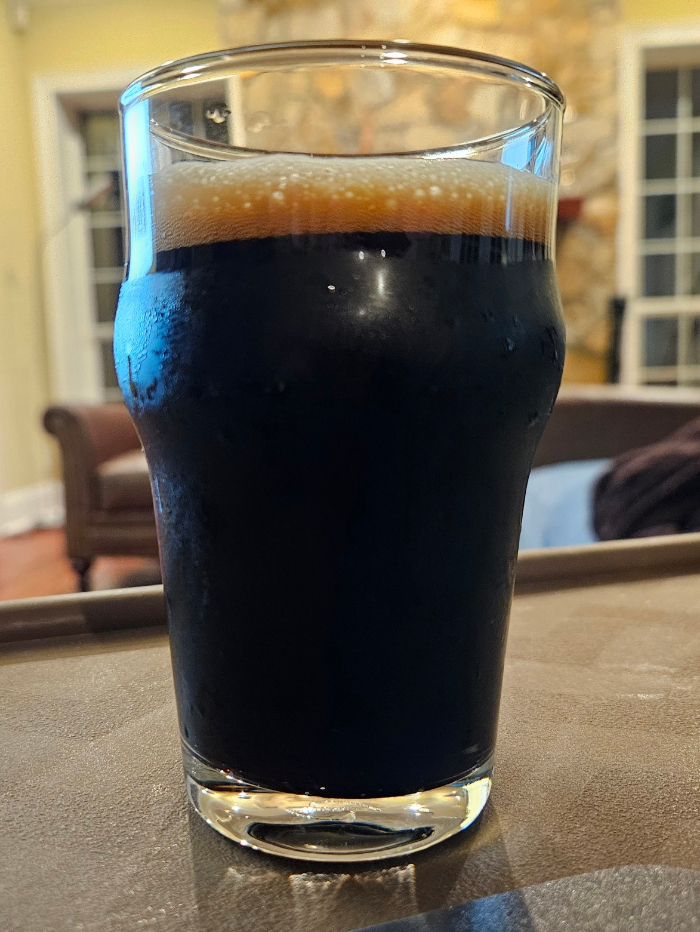Half a Wit is Better Than no Wit at All
November 26th, 2024Home Brewery Roars Back to Life
This was written on November 25.
It’s brew day minus one. I’m making Happy Halfwit Christmas Ale tomorrow.
I make a heavy ale called Happy Halfwit, and it’s magnificent. It contains a huge amount of wheat, which is weird for a heavy ale. I use Abbaye yeast, which was supposedly derived from Chimay dregs. This ale is sweet and very strong. Absolutely perfect. And it gets better with time. I made my last batch in January, and it’s at least as good as it ever was.
Almost two years ago, I got myself some St. Bernardus Christmas Ale, from Belgium. It’s dark and pretty heavy. It’s considered a quadrupel (spelled “quadrupel”), which means it’s what Americans call a “Strong Dark Belgian Ale.” It comes in at 10% alcohol, according to the Sint Bernardus (spelled “Sint Bernardus”) brewery.
I like this ale, but it has some funk to it. Belgians do weird things with beer, and sometimes their beer has smells and flavors people have compared to horse sweat and manure. I tried a Belgian-inspired ale made in America, and it made me think of Carnation Milk that had been in the can for 30 years, multiplied by 5.
I am trying to make a dark ale with little or no funk. If it has some banana overtones, which Abbaye sometimes produces, that’s fine, as long as they’re not overwhelming.
I’m using Special B malt as an ingredient. People tell me I’m using too much, but then they also claim I’m crazy to use Sabro hops, which are known to make beer taste a little bit like a pina colada. They say the malt will make the beer taste like prune juice. They may be right, but I already have the grain, and I can’t separate the Special B out. I’m going to go with it and change it next time if I need to.
I’m making a yeast starter. That means I’m taking a little packet of expensive yeast, mixing it with a malt extract solution, and letting the yeast multiply overnight. The idea is to overwhelm the beer and any microbes that might survive the brewing process. A starter is supposed to guarantee fermentation will go all the way, and it reduces the likelihood of infection by stray germs.
I am shooting for an original (prefermentation) specific gravity of 1.092, which is very heavy. Specific gravity is a ratio. It’s the density of the beer compared to the density of water. A lot of beers come in at around 1.040. Mine are generally around 1.055. A figure of 1.092 means there will be a lot of work for the yeast to do.
Sometimes, for reasons only yeast knows, yeast gives up, and then you’re stuck with beer that isn’t quite beer. I want to avoid that.
My new ale should come in at about 10% alcohol, which is perfect for cold nights by the fire. Not that I get much in the way of cold nights, but still.
I should be able to finish brewing tomorrow. Then I’ll stick the beer in a dedicated fridge at a fixed temperature. After that, I plan to make some of my favorite amber ale, and I need to replace my Last Trump lager, which is getting old.
I’ve been drinking my Steppe Brother Imperial Stout. I made it a long time ago, and I found it too sweet. I increased the carbonation level, and that added carbonic acid to the beer. Carbonic acid gives club soda its sharp flavor.
Here’s a photo of this beer in a miniature pint glass.
I like the beer now, and I’ve realized it’s not a failure. It’s a fantastic beer. It’s just sweeter than I intended when I wrote the recipe. I have grain for a new version, so I’ll be making that soon.
Other people who really like sweet beer would love this stout. If you can stand milk stout, which contains no milk but is full of unfermentable lactose, this beer will seem dry to you.
Imperial stout is a style the British exported to Russia. It was made very strong and dark. The intention was to make a beer that could survive an ocean crossing, supposedly. If you want to taste a perfect Imperial Stout, by a 4-pack of Old Rasputin, by North Coast Brewing.
After making my own imperial, I contacted North Coast, and they suggested I crank up the bitterness in my beer, so I’ll be doing that, going up to 76 IBU’s with Citra hops. As you might guess, they have a citrusy flavor.
My first batch of Steppe Brother fermented out in three days, which is crazy. I used a psycho yeast called Kveik Lutra. Kveik yeasts come from Norway or Sweden or something, and they are turbocharged. I got good results the first time around, so I’ll be using Lutra again.
Hoping to have a nice festive beverage available by Christmas.
